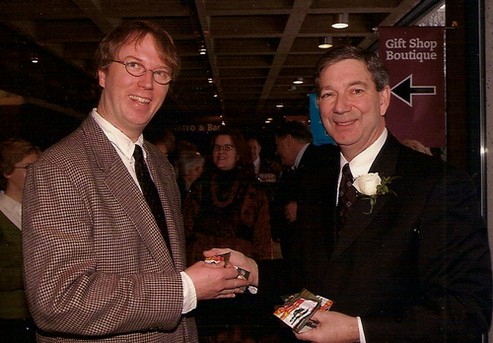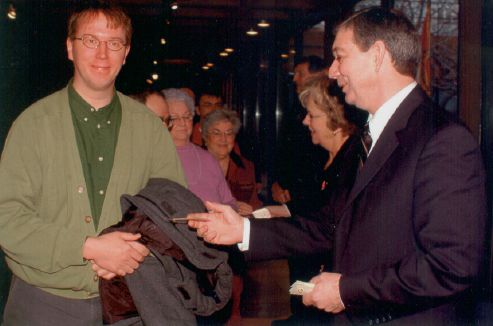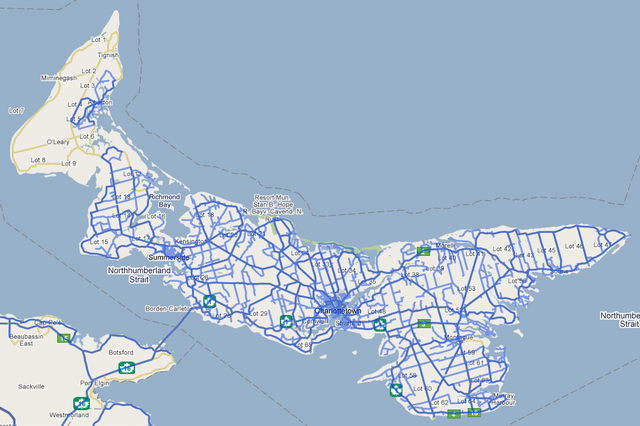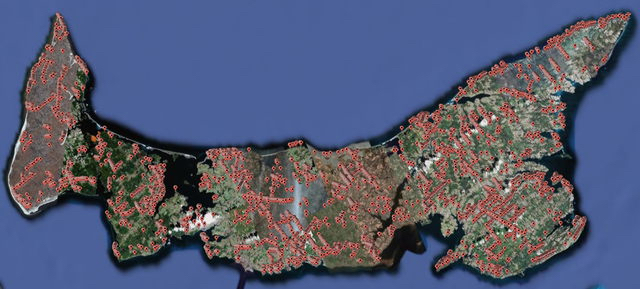Regular readers will recall a series of photos taken at the annual New Year’s Day Levee with Pat Binns, then-Premier of Prince Edward Island. Well, the tradition continues: I received my photo with now-Premier Robert Ghiz in the mail last week (another miracle of Prince Edward Island-ness: I never gave anyone my mailing address – they just figure it out somehow). Here it is, with photos of me and Pat Binns below for comparison.
I think you’ll agree that, although it was completely be accident, I scored a colour-coordination win this year. Notice as well that every year I seem to be getting a little closer to the Premier in the photo (in 2004 I appear not to notice that he’s standing beside me).
2010

2006

2005

2004

Esse quam videri means “to be, rather than to seem to be” and that’s how Bruce MacNaughton started off this week’s “Conversations with Bruce” taping.
With a somewhat distracting Michael Buble album playing in the background at Casa Mia Café, this weeks conversation was more wide-ranging than in previous weeks, but we circled around the same general subject matter: what’s the best way to engage the Prince Edward Island Preserve Company community in the digital realm.
Our conversation starts off with a drawn-out question from me prompted by an advertisement for Dauphin Kaffee in a recent issue of Monocle. The ad led readers to this landing page to register (or perhaps “apply”) for a free sample of their high-grade coffee. I was intrigued by the notion of replacing “everyone in the world” as a potential audience with “only a select few” and using the filter of “having visited the Preserve Company in New Glasgow” as a filter.
From there we jumped off to conversations about shipping rates, strawberry supplies, webcams on farms, the scenery in New Glasgow, an email from Sue in Australia, and “social media.”
Apologies for overuse of the word engage, the annoying buzz that kicks in at 03:30 (it was a cooler across from us, I think). And apologies to Bruce for using the goofy hands-at-ears thumbnail for the video, but I couldn’t resist.
Last week I accidentally set up our phone system here at Reinvented HQ up in a way that has accidentally worked out quite well.
We have a main business number that’s a regular old analog telephone line. It’s listed in the phone book, and is the main point of contact for our business. As a result, I get a combination of distracting “can I speak to the person responsible for your telecommunications services” spam calls, calls reminding me of physiotherapy appointments, and calls reminding me to come home for dinner … the kinds of calls I can either safely ignore, or at least get back to later.
We also have another number that I set up a few years ago for the convenience of our colleagues at Yankee Publishing. This line, which is a virtual VOIP line, is a local number in Dublin, New Hampshire.
My “accidental” configuration change was to shunt all calls to the main business number to voicemail, but to route all calls to our New Hampshire number directly to the phone on my desk.
The result: much less distraction from the background noise of everyday regular telephone communication, but instant access for our client when they need to talk to me.
It’s working out quite well.
Catherine and Oliver saw the Google Street View car last year while walking down University Avenue. And the Google Street View car saw them.
Oliver’s childhood has been blessed by the presence of the excellent local toy store Owl’s Hollow in his life. Owl’s Hollow is the sort of toy store you want to have in your life: broad and eclectic selection, friendly and helpful staff, and the kinds of toys and games you just won’t find stacked up at Walmart.
The store has always had a tiny books section at the back of the upper level; last year this expanded significantly and got a new place in the store just behind the cash. And over the last few months the selection of books has expanded even more.
So now in addition to Dr. Seuss and Goodnight Moon you will find everything ever written by David Sedaris, the Moosewood Cookbook, books about parenting, a chocolate exposé, a good selection of books on “children from other lands” and a nice cross-section of the sort of “middle school fiction” that Oliver’s just starting to get interested in.
I’ve slowly come to the realization that what I need in my life is not a bigger selection of books (or music, or movies, or …), but a smaller and better-curated selection.
That’s what the Owl’s Hollow book section is: packed into less than 100 square feet a rich, well-tended collection of books that means I emerge having purchased two or three every time I visit.
It’s all over the ‘net this morning here on Prince Edward Island that Google has finally turned on the Street View images on Google Maps that they shot last summer. There seems to be coverage of almost the entire Island, except for West Prince, which was left out for some reason (blue roads on the map are Street View-enabled):

What sets Prince Edward Island apart from, well, the rest of the world, is that there is some truly stunning imagery in their collection:
The Google Car’s tour of downtown Charlottetown seems to have happened on a particular resplendent summer day, and our house at 100 Prince Street is captured in all its glory, complete with Catherine’s gardens in full bloom.
After our tour of the Prince Edward Island Preserve Company building on Wednesday afternoon, Bruce MacNaughton and I retired to his office in the top corner of the old New Glasgow butter factory to talk more about his business, his business online, and whether it’s possible to approximate online the experience of visiting the Preserve Company in person.
This week in my Conversations with Bruce series I drove out to the Prince Edward Island Preserve Company in New Glasgow for a tour around the place with Bruce MacNaughton.
The camera work is a little sketchy and points out the value of having a camera operator whose only job is to make sure that it’s not only half of people’s heads that are in the frame – it’s hard to talk, walk, and focus the camera all at the same time!
I got an email late last week of the sort that I’d like to receive every week but that, alas, are very rare. Art Ortenburger, a home-schooled teenager from Bonshaw, lives in an area of Prince Edward Island where Bell Aliant isn’t currently providing broadband infrastructure (despite promising end-to-end broadband for the Island by the end of 2009).
Art was curious to know exactly how many addresses on the Island were in the same boat, and, being a sharp guy, he set out to use Aliant’s own lookup tool to find out.
Art wrote a well-crafted set of automated tools that takes every civic address in the freely-available PEI Civic Address Database and submits each one to Aliant’s web page. That page responds with either “Congratulations! You can choose from the following list of services currently available to you…” or “Your address … does not currently qualify for Bell Aliant High Speed Internet service.”
Art’s “bot” is well-tempered: it only submits one query a second, so it takes several days to run. And this left Art with a problem: he didn’t have a server on which to host the tool. And so he got in touch with me.
I was happy to provide a mechanism for the tool to do its work, and on Friday night I fired up an Amazon EC2 instance and set the script running. Three days later, the results were:
- Total Addresses: 68,040
- Addresses with no DSL: 10,439
- Addresses with Basic DSL: 19,559
- Addresses with Ultra DSL: 38,039
Here’s what a Google Earth map of the addressed with no DSL service looks like (click the image for a larger version):
If you’re interested and have Google Earth yourself, download the Google Earth file of the no-DSL addresses and zoom in to any area of the province to see the situation in detail.
Keep in mind, of course, that what Art’s tool looks up is civic addresses, not “households that might want to have broadband Internet installed,” and so among those 10,439 non-served addresses are everything from vacant lots to barns (although what farmer in their right mind doesn’t want DSL in the barn these days).
Art has released his complete toolset with a GNU open source license so you can see how the magic works, run the bot yourself, or just get some ideas on how to write automated tools in Python.
As a follow-up to last summer’s (warmer) Weekend in Halifax, here’s a few more notes about visiting the city, based on a quick (colder) trip we took over this weekend.
- On a whim I bid $50 for two rooms in Halifax on Priceline and it was, to my surprise, accepted by The Westin Nova Scotian. The hotel is perfectly acceptable, if (very) slightly off the beaten track. They charge $18/night for parking, but somehow we were exempted from that. There’s nice little swimming pool, a very well-equipped fitness room (the treadmills have built-in televisions), and the rooms are comfortable. The only downsides were that it was hard to control the temperature in the rooms, and that the entire hotel bristled with static electricity, making for a shocking weekend. But for $50, who’s complaining.
- We had another great dinner at Chabaa Thai Restaurant on Saturday night. We arrived about 15 minutes before the supper rush and by the time we left the place was packed to the gills. Our friend (and world traveler) C. was with us and this broadened us out of our usual Thai menu habits, so we got to taste more of what they offer. The spicy halibut was especially good.
- Dartmouth Crossing, which had been positioned in my mind as a sort of mainland shopping nirvana, turned out to be a depressing industrial shopping wasteland full of the same-old same-old big-box stores. Best avoided.
- We made our first visit to the Art Gallery of Nova Scotia based on a recommendation of the Machines at Play show helpfully tweeted by Iain. It had a very high neato quotient, and the rest of the gallery was interesting too. Best $20 (per family) you can spend in downtown Halifax, I think.
- Conversely, the Discovery Centre’s much-hyped LEGO exhibit turned out to be little more than a bunch of LEGO models of iconic American scenes with some LEGO brick-filled tables sprinkled around. I love LEGO, and the our visit to LegoLand was one of the highlights of my life, but this had nothing at all to do with “discovery” and was more of a promotional opportunity for LEGO. The rest of the Discovery Centre is much more straight-ahead science centre-like, albeit with exhibits that look like they haven’t been refreshed in 10 years. While not completely without value, the overall impression one is left with is of a poorly-funded and unloved facility that pales when compared to any other children’s museum we’ve visited.
- On Sunday night we used 2-for-1 coupons from The Coast to go out to dinner at The Wooden Monkey in its large new location on Grafton Street around the corner from where it started out. The service and the food were both excellent and this remains our favourite place to eat out in Halifax.
- On Monday morning we drove over to Dartmouth to visit Chairs Limited, a bespoke chair maker. Met a very helpful salesperson who guided me through the options available (which turned out to be “almost anything you can imagine”). When I joked that I’d like a chair upholstered in the Prince Edward Island tartan he excused himself for a moment and emerge shortly with both PEI- and New Brunswick-tartan covered chairs. I’m preparing my chair order now.
- I put out a call on Twitter for a new coffee place to try out and the consensus from all corners was Two if By Sea in Dartmouth. So on our way out of town we stopped in. Wow. They have a pain au chocolate on the menu that is indescribably good (albeit also indescribably rich) and also serve a very solid espresso. Not the kind of place you could go every day, but certainly worth a visit to see how croissants are supposed to be made.
We packed a lot into 48 hours, and then made quick work of the trip back to Charlottetown, darting between snow squalls all the way.

 I am
I am